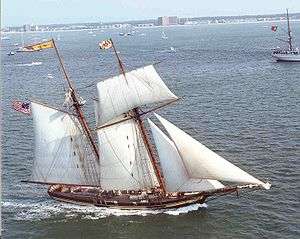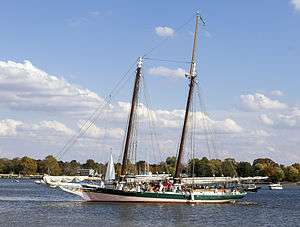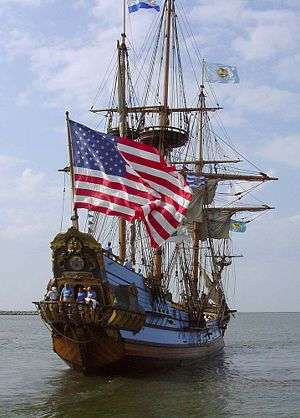Thomas C. Gillmer
| Thomas C. Gillmer | |
|---|---|
| Born |
July 17, 1911 Warren, Ohio |
| Died |
December 16, 2009 Annapolis, Maryland |
| Nationality | USA |
| Education | U.S. Naval Academy |
| Spouse(s) | Ruth Newsome |
|
Engineering career | |
| Discipline | Marine Engineering |
| Practice name | Thomas Gillmer, Naval Architect, Inc. |
| Projects | Ship Hydromechanics Laboratory (U.S. Naval Academy) |
| Significant design | Pride of Baltimore and Kalmar Nyckel |
Thomas C. Gillmer (1911–2009) was a naval architect and the author of books about modern and historical naval architecture. He was born in Warren, Ohio on July 17, 1911. At his family's summer cottage near Lake Erie in Ohio, he learned to sail a 14-foot sloop by himself. He graduated from Warren High School, then attended the U.S. Naval Academy.[1]
After graduating from the U.S. Naval Academy in 1935, he served aboard the light cruisers USS Raleigh (CL-7) and USS Savannah (CL-42) in the Pacific and Mediterranean.[1]
In 1941, he joined the Marine Engineering Department at the Naval Academy. During World War II, he served as an instructor of Ship Construction and Damage Control at the U.S. Naval Academy. He resigned his commission with the Navy in 1946 to join the Academy's faculty as a professor and became chairman of the First Class Committee of the Marine Engineering department. (Note: The Marine Engineering Department became the Division of Engineering and Weapons in 1970 which contained the Naval Systems Engineering Department. Naval Systems later became the current Naval Architecture and Ocean Engineering Department.) During the 1950s, Professor Gillmer established the Ship Hydromechanics Laboratory in Isherwood Hall which consisted of an 85' × 6' × 4' towing tank, an 18' × 22' × 4' intact and damaged stability demonstration tank and a small circulating water channel.

After retiring from the Naval Academy in 1967, Gillmer continued living in Annapolis, where he pursued a career as the architect of sailing vessels and an author on the subject. In 1969, he established the engineering firm Thomas Gillmer, Naval Architect, Inc. in Annapolis.[1] His designs included modern yachts and replicas of historic sailing ships.[2] He worked with artist Melbourne Smith on the design of the Pride of Baltimore in 1976, the Pride of Baltimore II in 1986, and the Kalmar Nyckel in 1997.[3] The Navy hired Gillmer to evaluate the condition of the USS Constitution prior to the vessel's restoration in 1997.[1]
The Allied Seawind Ketch, designed by Gillmer in 1962, was the first fiberglass-hulled yacht to circumnavigate the Earth.[4]
Gillmer designed and built his own house in Annapolis in 1947, where he lived for more than 60 years. He was married for 62 years to the former Anna Derge. After her death in 1999, he married Ruth Newsome, who was his wife until he died on December 16, 2009.[1][5]
Bibliography
Books
- Fundamentals of Naval Construction and Damage Control, with Jamie Adair, U.S. Naval Institute Press (1949 and 1951)
- Fundamentals of construction and stability of naval ships, United States Naval Institute (1956, revised 1959)
- Working watercraft: a survey of the surviving local boats of America and Europe, International Marine Pub. Co. (1972), ISBN 0-87742-025-4
- Modern Ship Design, Second Edition, U.S. Naval Institute Press (1970, revised 1975)
- Cruising designs from the board of Thomas C. Gillmer, Seven Seas Press (1975)
- Introduction to Naval Architecture, with Bruce Johnson, Naval Institute Press (1982), ISBN 0-87021-318-0
- Chesapeake Bay Sloops, Chesapeake Bay Maritime Museum (1982)
- Sailing With Pride, with Greg Pease (Photographer) and Barbara Bozzuto (co-author) (1990)
- Pride of Baltimore: The Story of the Baltimore Clippers, 1800-1990, International Marine Publishing (1992), ISBN 0-87742-309-1
- Old Ironsides: the rise, decline, and resurrection of the USS Constitution, International Marine (1993), ISBN 0-87742-346-6
- History of Working Watercraft of the Western World, the McGraw-Hill Companies (1994), ISBN 0-07-023616-X
- Old Ironsides, International Marine/Ragged Mountain Press (1997), ISBN 0-07-024564-9
Video
- Maritime archaeology and ship preservation, U.S. Naval Academy (1998), with Dana M. Wegman, Patrick Otton, Robert O. Dulin, William H. Garzke, Peter K. Hus, and Timothy J Runyan
Vessel designs


Historic sailing ship replicas
| Vessel design | Year designed | Overall length | Type |
|---|---|---|---|
| Pride of Baltimore | 1976 | 90 feet | Topsail Schooner |
| Lady Maryland[6] | 1979 | 104 feet | Pungy Schooner |
| Pride of Baltimore II | 1986 | 157 feet | Topsail Schooner |
| Kalmar Nyckel | 1997 | 93 feet | Pinnace |
Sailboats
| Vessel design | Year designed |
|---|---|
| Blue Moon 23 | 1943 |
| Blue Water 24 | 1961 |
| Allied Seawind Ketch | 1962 |
| Allied Seawind Sloop | 1962 |
| Privateer 26 | 1966 |
| Privateer 35 | 1968 |
| Aries 32 | 1972 |
| Seawind Mk 32 Sloop | 1975 |
| Seawind Mk 32 Ketch | 1975 |
| Roughwater 33 | 1975 |
| Southern Cross 31 | 1977 |
| Southern Cross 28 | 1978 |
| Southern Cross 35 | 1978 |
| Passage 24 | 1979 |
| Southern Cross 39 | 1981 |
| Weatherly 32 | 1983 |
Source of table data:[4]
References
- 1 2 3 4 5 Frederick N. Rasmussen (December 25, 2009). "Thomas C. Gillmer". The Baltimore Sun. Retrieved December 29, 2009.
- ↑ "About Thomas C. Gillmer, N.A.". Privateer 26 website. Retrieved December 22, 2009.
- ↑ "Kalmar Nyckel Ship Specifications". Kalmar Nyckel Foundation website. Retrieved February 1, 2010.
- 1 2 "Thomas Gillmer". SailboatData.com. Retrieved December 22, 2009.
- ↑ "Thomas C. Gillmer". The Bowie Glade-News. December 18, 2009. Retrieved December 30, 2009.
- ↑ "Lady Maryland". Living Classrooms. Retrieved December 28, 2009.
External links
- www.KalmarNyckel.org Kalmar Nyckel website
- www.Pride2.org Pride of Baltimore website